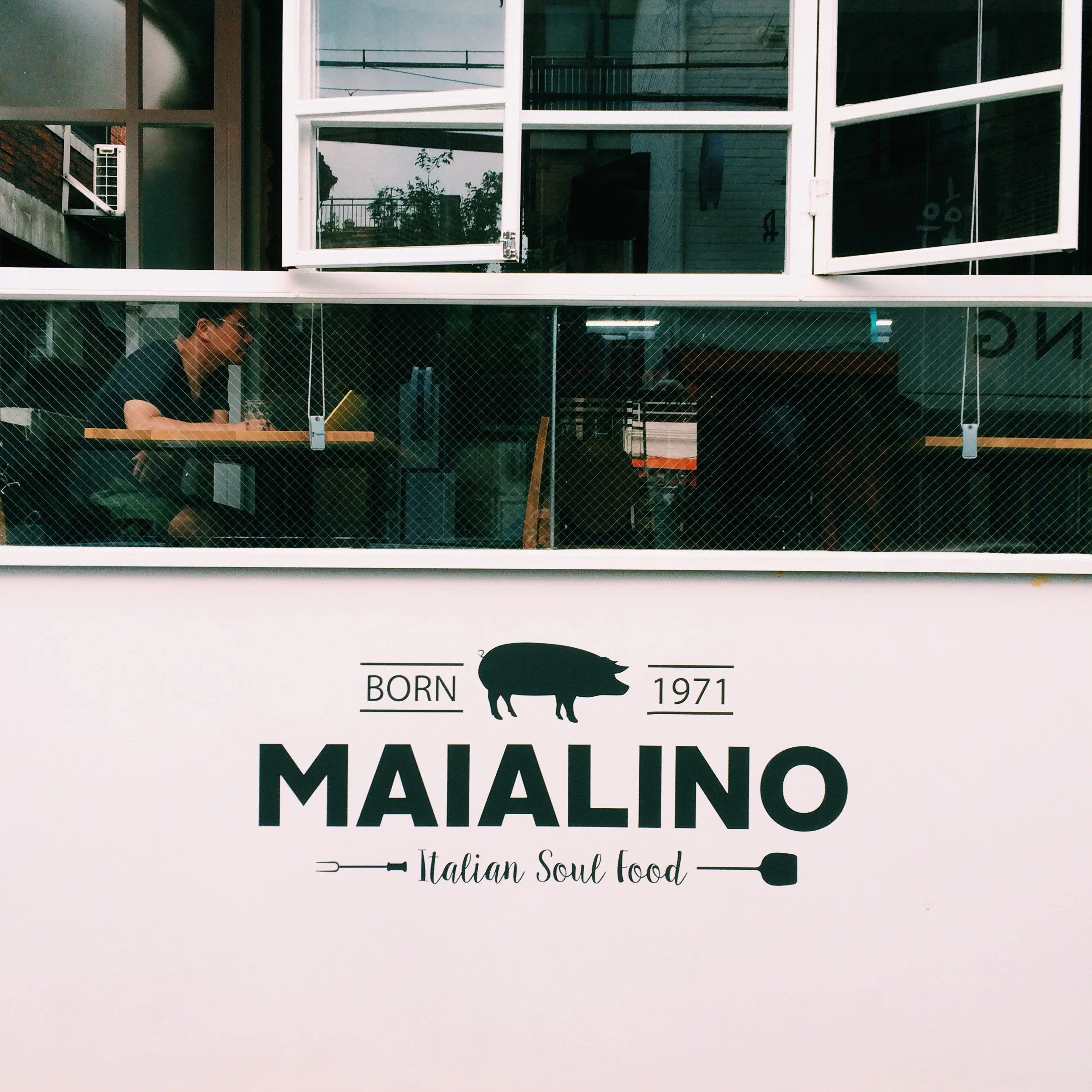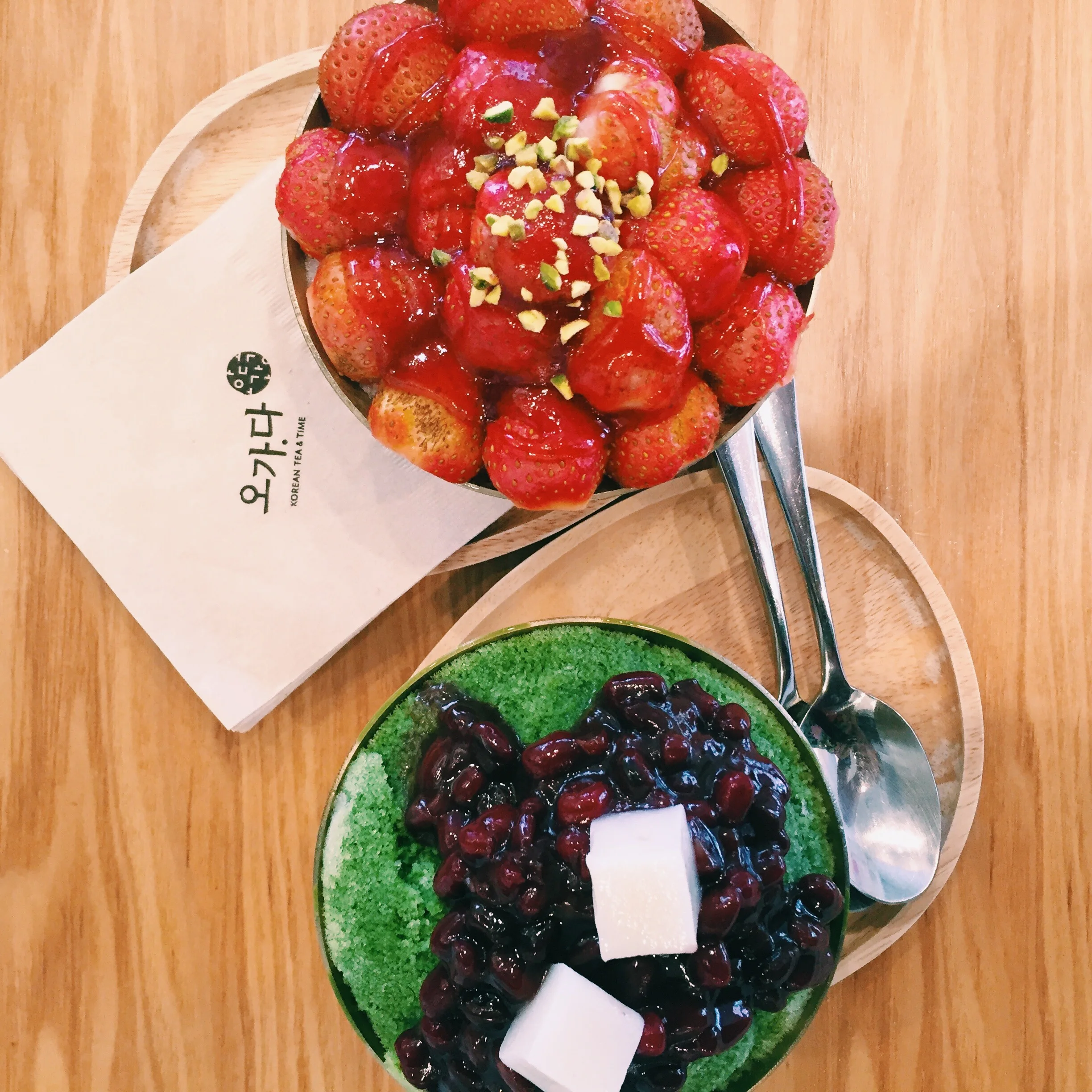A Few Fun Things About Seoul
Sitting on a bench, deciding what to do next. Tough life, right?
Jmo and I are pretty comprehensive travelers. We like to plan way ahead to make sure we're seeing all the things we want to see while, at the same time, factoring in just the right amount of wandering and rest. However, this recent trip to Seoul was a little different for us. For the first time in our lives as a couple, we went on an international journey with almost no plan (except of course to meet our son and appear in court). Because we were focused on the adoption portion of the trip, we neglected to put much thought into how we'd fill the rest of the hours and days we'd be in the city.
And then something wonderful happened: We stepped outside of our hotel each day and discovered how much Seoul had to offer as a genuine vacation destination. I'm so happy to return home and report how much we loved our time there. Here are a few reasons why:
The city is vibrant.
9 p.m. in the heart of Mapo-gu district, a couple blocks from our hotel.
When we finally got to our hotel on the first night, we were absolutely bushwhacked from the flight. Looking at our watches, we realized we’d been up for almost 24 hours! It was around 8:15 p.m. and though a giant invisible magnet seemed to be pulling me against my will straight into the comfy bed in our hotel room, Jmo managed to convince me a walk around town and dinner would serve us better. (Gotta stay up a little later to get on a normal sleeping pattern). So out we went. He’s such a smart man, that one.
We stayed in the Mapo-gu district (our agency is just down the way from our hotel there) and it’s very close to Hongik University. So we found ourselves in the middle of a bustling streetscape teeming with exuberant young people all walking with a purpose toward whatever interesting diversions awaited on a warm Sunday night.
Even at the end of a weekend, nothing seemed close to shutting down. In fact, the area immediately around our hotel appeared to be having a street fair. Young kids were out doing impromptu hip-hop shows to the delight of onlookers. The streets were lined with skyscrapers, restaurants serving both traditional Korean food and some American, Japanese, Vietnamese and even Lebanese fare and health and beauty shops selling all kinds of interesting makeup and skincare items.
The place was a cacophony, with restaurants and businesses playing K-pop, U.S. pop, hip-hop and traditional Korean music. After browsing for a while, we ducked into a noodle shop and found a simple Udon dish we both liked. And then we went home and passed out.
Spas are an everyday thing.
In Korea, the spa experience isn’t considered a luxury. Rather, for centuries, it has been deemed an important part of maintaining total wellness. To that end, there are spas everywhere (traditional ones are called jimjibang), catering to people of all income levels. They're usually open 24 hours and it's normal for people to check in in the evening and stay all night soaking, misting and napping.
Much less precious than in the U.S., Korean spas are drop-in locations with several saunas, pools and exfoliating and massage services, usually divided by gender, that anyone can walk into for a pretty reasonable price. While I’m sure there are very high-end spas in Seoul, the places I observed look more like YMCAs on the interior (again, it’s not about being fancy, it’s about being well). Our hotel seemed to have a very nice spa called Happy Day. I’m kicking myself for forgetting my bathing suit because this was probably my only opportunity to duck into one. (We’ll have our little one next time, and I’m guessing I’ll want to be with him every single second.)
A note: In the traditional jimjijbang, the attire of choice is the birthday suit. So I could have actually gone in, but just wasn't feeling up to the .... err ... exposure.
Communication is easy.
This is a wall in the subway tunnel that projects advertisements 24/7. I'd say the title "Brand Theater" is pretty appropriate.
English is everywhere in Seoul, which is good and also sorta bad.
Good for us, as it makes things so much easier to communicate when the street signs are almost uniformly in Korean, Chinese and English. Also, seven out of 10 people you will meet here speak English well. So ordering a triple-shot latte was a piece of cake. But its bad because we’re not forced to use any of the Korean we’ve been learning, and we do want to get better with this before our son arrives.
People are exuberant.
The green (and very clean) Seoul subway system.
We traveled to several districts and, although the vibe was different in each one, the energy was always palpable. On the sidewalk, even at 7 a.m., we passed best girlfriends with arms linked chatting away or mothers and daughters smiling and walking hand-in-hand. Groups of young men and young women alike seemed to somehow be having the BEST TIME EVER just walking down the street.
On the subway one evening, we observed two women in what we guessed was their late-70s chatting amicably and animatedly with one another. I thought for sure these two must go way back. But surprisingly, a couple stops in, one woman got up from her seat and said a polite "goodbye" to the other before heading on her way. So these two were likely strangers before that one brief moment and yet, in that same moment, they became best buds. This episode repeated itself twice, with two different women getting on the train to sit next to the woman across from us. Each time, the women struck up conversations that made us think they'd known each other all their lives. In a world of stranger danger and "do not approach me" eyes, this interaction was so refreshing to witness.
Sheet masks abound.
A page from a popular Korean fashion magazine depicting women wearing various types of sheet masks.
In Seoul, the prevalence of beauty and makeup chain stores rivals Starbucks. Popular establishments like Olive Young, Nature Republic and Tony Moly appear every few blocks as if to say, "Oh, here I am again. And I have all the sheet masks." I wasn't very familiar with sheet masks before embarking on this trip, but I was looking forward to trying a few out during our stay.
And I loved them! For about $$2.50-$3.50 USD, you can tear open a package full of goo-laden silicone patches and place them on your face for 20 minutes.
The skin-colored ones made me look like the latest Zombie Apocalypse recruit, so Jmo was a little unnerved. But in Korea, they take the design of their sheet masks seriously. So in addition to the basic ones, some companies are now offering masks with masquerade-ball designs, lace patterns and even animal features (frisky, right?).
In addition to the fun you can have with trying different designs, there are some superficial benefits, too. I really liked the way my skin felt after removing this zingy lemon-infused sheet mask. So these little gems, plus a warm bath and a glass of red wine each night helped to alleviate my lingering jet lag and generally make me feel a little better about the amount of self-care I was able to administer even if my brain felt fried.
It’s easy to find delicious, healthy food.
One of many gorgeous, delicious restaurants in Seoul.
We don't eat meat and and we shy away from much dairy, so traveling internationally can sometimes be a challenge. This past winter, when we visited South America, our traveling companions wisely packed a small suitcase full of energy bars, peanut butter, bread, crackers, nutrition shakes and more just in case restaurant pickings were slim. And in Buenos aires, they proved to be so.
That pretty much sums it up.
Thankfully, we didn't have to take such measures in Seoul. The city is teeming with traditional Korean restaurants as well as international establishments serving plenty of fresh vegetable, noodle and rice-based dishes. Two of our favorites were Maji, which served "Temple Food" exclusively. (Food that is mostly vegetarian and excludes certain foods as dictated by religious practice.) I had soy bulgogi and Jason ordered a traditional bibimbap, a rice bowl topped with beans (in this case) and vegetables and served with traditional pickled vegetable varieties (kimchi) on the side. We also really loved the vegetable curry and tandoori vegetable dishes at Sitara, an Indian restaurant in Mapo Gu. Both the takeout and eat-in meals we had there were wonderful.
Soy bulgogi and condiments at Maji
And then there were the cold noodles: Neither of us had ever tried traditional Korean cold noodles before, but in the heat of summer, we fell in love. Served in an ice bath of radish broth (trust me!) sticky bound noodles that resembled soba mingled with various types of kimchi, daikon, turnip and seaweed. These types of noodles often come with kitchen-safe scissors diners use to cut the noodle chunk so it disperses into the broth.
Finally, there was the "snow". I'd tried snow, which is sort of a lighter, fluffier version of Hawaiian shave ice, before. When it's good, the texture is really that of freshly fallen snow, which makes it a great mid-afternoon treat on a hot day. We loved both the flavor combinations and fun presentation elements of the snow we ordered in Seoul. Our favorites were a green tea / adzuki bean combination topped with fresh mochi (my choice) and a fresh strawberry variety (Jmo's choice).
The Best Snow Ever
Have you ever approached an international trip with abandon? I want to know all about it! Drop me a line in the comments section.















